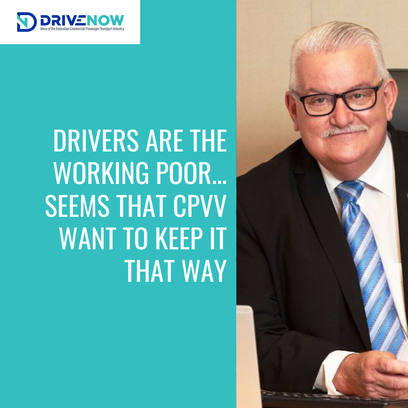Apart from what appears to be the selection of specific data to skew the analysis, there lies other inconsistencies in the report. While the report legitimately separates fares collected in different zones (metro, urban, regional and country), it does not separate data collected from taxi and rideshare.
Taxi and rideshare drivers are some of the lowest paid workers in the country. The CPVV don’t even pretend to care. By failing to differentiate between the two services, it is impossible to determine whether an abuse of market power exists. Maximum fare rates for unbooked taxi services are government regulated, while rideshare operators are left to their own devices. For pre-booked work, it is also known that despite taxis being able to set fares outside of regulated rates, fares are calculated to sit fairly close to what would have been on the meter otherwise. By choosing to lump rideshare fare data with highly regulated taxi fare data, the report conceals where the abuse of market power may lie and that is within the dynamic pricing model in the rideshare sector. Rideshare operators have long employed surge pricing strategies to exploit demand, yet this is not acknowledged in the report. The CPVV has failed to conduct a meaningful analysis of the data, preferring to provide a skewed version of reality that suits its narrative of the industry. Even more condemning is the CPVV’s view of market economics. The CPVV celebrates that the industry managed to grow by increasing the number of driver accreditations and vehicle accreditations in 2020 during COVID-19, despite a downturn in the number of trips by an average of 57%. This is an alarming perspective. Why is CPVV rejoicing in extreme market saturation and an unsustainable level of competition within the industry? This report makes clear the attitude of the CPVV. It will prioritise competition over all else, forcing drivers to work one, two and three jobs just to put food on the table. According to data submitted by Uber to a Senate inquiry in March this year, drivers and delivery workers in Sydney make less than the minimum wage for casual workers, even at peak hours. On top of this, drivers must pay for their own vehicle, petrol, insurance and superannuation. The Transport Workers Union found 74% of surveyed food delivery workers reported they were struggling to pay their bills and buy groceries. It surprises me every day that CPVV does not see this as a legitimate concern. I believe that drivers should not be slaves to the middle class. Someone must pay for the real cost of providing the service. CPVV must address the level of market saturation to ensure that the industry is commercially sustainable, and drivers can earn a living wage. More news in our September 2021 Edition here.
1 Comment
22/9/2023 10:21:46 pm
This blog brilliantly sheds light on the often overlooked issue of how drivers, who are an essential workforce, are disproportionately affected by low wages and poor working conditions. It compellingly highlights the important role played by organizations like CPVV in perpetuating this problem. By exposing these issues and encouraging dialogue, the blog contributes to the ongoing conversation about workers' rights and the need for fair compensation and improved working conditions for drivers. It's a thought-provoking and eye-opening read that urges us to reevaluate the treatment of the working poor within this crucial industry.
Reply
Leave a Reply. |
NewsDRIVE NOW reports on various topics regarding the Archives
December 2022
Categories
All
|
DRIVE NOW Magazine is published by Trade Promotions Pty Ltd, Ashwood VIC Australia. © 2022 DRIVE NOW |


 RSS Feed
RSS Feed